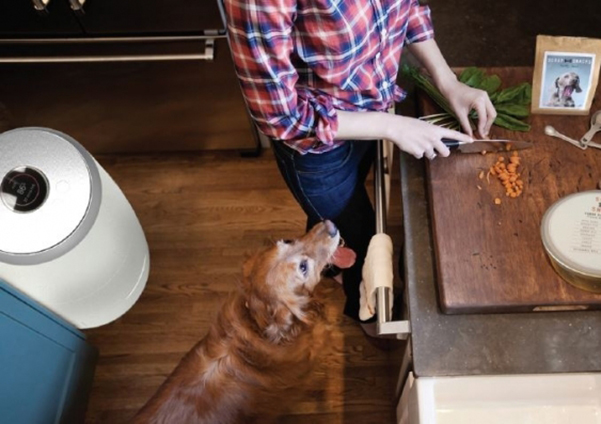
Industrial Design student Greta Saggus initially wanted to address the large-scale problem of food waste in restaurants, but decided the home front was a good place to start.
“I live in a share house and we don’t have much of a garden. We all buy food but then we might end up going out to dinner, so I know first-hand how easy it can be to waste food. And composting is not always a solution, particularly if you live in an apartment,” she says.
Saggus says Australians throw away around 20% of the food they buy, which adds up to around $8 billion in food wasted every year. And it is not only the cost, but also the environment that suffers, with more landfill and increased greenhouse gasses.

Image: supplied by Greta Saggus.
During her research phase, Saggus discovered that coincidentally Australians spend a similar amount, around $8 billion, on their pets each year, with much of that on pet food.
The 21-year-old saw an opportunity to help reduce the problem of food waste as well as ease the cost of pet ownership.
Saggus set about developing a product that could easily turn kitchen leftovers into dry, long-lasting pet food that would be a tasty and nutritious snack for both dogs and cats.
She borrowed a blender and used it to grind up different combinations of kitchen scraps, which she then dehydrated in an oven. She enlisted the help of friends with pooches to try out the treats.
“The dogs really loved the treats, that’s what made me realise that this could actually work,” she says.
One of the things Saggus discovered as she looked at different recipes was the high amount of salt and fat in some pet food.
She realised her nutrient rich, home-made dry pet food was not only good for the environment and the wallet, but also good for pets' health.

Image: supplied by Greta Saggus.
“I was also surprised to discover how many pet owners were spending a lot of time making home-made meals for their pets rather than purchasing pre-made products. So I felt that I was tapping into a growing trend,” she says.
The next step in developing her project was the ‘industrial design’ phase and Saggus looked at a wide range of kitchen appliances, including blenders, dehydrators and mincers, to work out how she could combine their actions into one product.
The appliance evolved into a neat all-in-one unit, similar in size to a kitchen bin, which could blend, extrude and dehydrate scraps, converting them into pellets in a range of sizes.
The design was on display at the Industrial Design Graduand Exhibition this week at the Michael Crouch Innovation Centre on UNSW’s Kensington campus.
“Saggus’s is the standout project this year because it is easy to relate to and offers some genuine innovation,” says UNSW Director, Industrial Design, Stephen Ward. “Using waste food in this way ticks boxes in waste reduction and urban living,” he says.
Saggus estimates that using her product could reduce organic household waste by 360kg and save up to $190 per pet annually and she is now exploring the potential for commercialisation.
“This nutritious, cost-effective and environmentally friendly solution means healthier pets, less wasted resources, money saved and an all-round better solution for how we use and share food in the home,” she says .
“There has been such a positive response. A lot of people have said they would love to have this in their home, so I'm hoping to put the project on the crowdfunding platform Kickstarter.”
If you are interested in solving real world problems with sustainable ideas, then check out our Industrial Design degree here.
